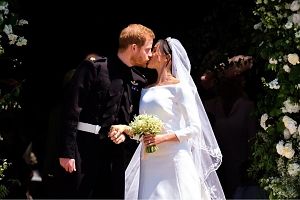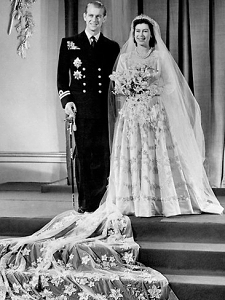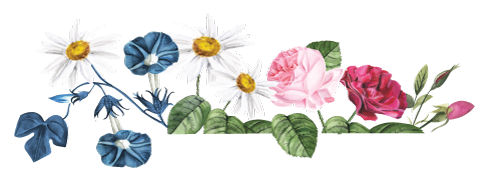
You could say that it all started with Queen Victoria. When the British monarch married the love of her life, Prince Albert of Saxe-Coburg and Gotha, on February 10th, 1840, the papers and the public were smitten. The Queen bride’s sartorial choice that day was later credited for famously popularizing the white wedding dress, which was still not de rigeur for virginal brides in the proceeding centuries. The orange blossom wreath that anointed her wedding day hair also became a staple for Victorian brides. Some wax iterations of these crowns still survive, but the legacy of this accessory may be felt most strongly among the Bohemian-minded women who frequent Stone Fox Bride.
During the Victorian era, bridal bouquets also functioned as fashion accessories unto themselves throughout high society at large. Unlike today, when bouquets are generally viewed as objects of ephemeral home decor, bouquets in the nineteenth century were full-fledged accessories. Women carried them to court presentations and balls, as well as to their own weddings. In other words, carrying a bouquet that matched your outfit was pretty much standard procedure.
By the time Queen Victoria’s son and heir, Edward VII, married Princess Alix of Denmark, it had become customary for brides to match the hue of their bouquet to their white dress. Alix’s wedding ensemble included garlands of flowers pinned to the skirt of her voluminous dress (a floral trend that should perhaps be revived!), as well as a pale bouquet. According to Jennifer Davies, author of The Victorian Flower Garden, Alix’s soon-to-be mother-in-law, Queen Victoria, insisted that she carry a sprig of myrtle in her bouquet. Why? Well, back then myrtle was believed to symbolize love.
After Alix’s wedding was over, Victoria did a sweet, and farsighted thing and ordered that a sprig of myrtle from her daughter-in-law’s bouquet be planted in the grounds of one of her many palaces. The intention was for the next bride in the British royal family to include a sprig from this new flower in her own wedding bouquet. For years, brides in the family continued the tradition, passing along a lone stem of myrtle for the next generation of women.
It’s unclear how many of these plants actually took root and grew. (As Davies notes in her own account, it is very difficult to get a sprig of myrtle to grow an entire, thriving plant.) But what is clear is that Windsor brides, including Queen Elizabeth, Princess Diana, Kate Middleton, and most recently, Meghan Markle, still carry a sprig of myrtle in their bouquets today.
The royal family bouquets prove that such wedding arrangements can be imbued with meaning and family tradition. And while you could go ahead and attempt to start a similar tradition of your own, there’s no harm in copying some famous royal bouquets in the meantime.
Queen Elizabeth’s Bouquet

When the young Princess Elizabeth married Prince Phillip in 1947, she carried three different species of white orchids, along with that special sprig of myrtle. The flowers in question, like those of her predecessors and successors, were grown throughout the United Kingdom.
Princess Margaret’s Bouquet

On May 6, 1960, Princess Margaret married photographer Anthony Armstrong-Jones. In two respects in particular, Margaret’s wedding day ensemble was decidedly more understated than that of her older sister. The princess’s dress was free from the embellishments that had characterized Elizabeth’s own gown, and she carried a much smaller bouquet. Although the arrangement, which included orchids, stephanotis, lily of the valley, and myrtle, was not dissimilar in structure to the one carried by her sister.
Princess Diana’s Bouquet

In 1981, when Princess Diana married Prince Charles, her cascade arrangement was as large as the pouf sleeves on her dress and reportedly weighed around four pounds. She carried orchids, myrtle, ivy, freesia, lily of the valley, and Earl Mountbatten roses, named after her groom’s beloved uncle, among other flora.
Kate Middleton’s bouquet

In the twenty-first century, Kate Middleton made an elegant and understated choice of her own. The Duchess of Cambridge’s bouquet included a variety of flower species, but at a glance, its timeless use of lily of the valley dominated its appearance. A worthy choice of flower indeed, and one which, like sprigs of myrtle, hints at tradition. The Duchess of Cambridge’s bouquet also included a flower known as Sweet William, a fitting choice, considering her husband-to-be.
Meghan Markle’s bouquet

Like her new sister-in-law, the Duchess of Sussex’s bouquet was a small arrangement dominated by lily of the valley. In addition to myrtle, her bouquet included sweet peas and jasmine, as well Forget-Me-Nots, a favorite flower of Prince Harry’s late mother, Diana. To top off the sentiment behind these blooms, the flowers in question were picked by Harry himself from their private garden. Above and beyond the call of husbandly duty? Yes, but it’s actually a traditional gesture from the groom.












